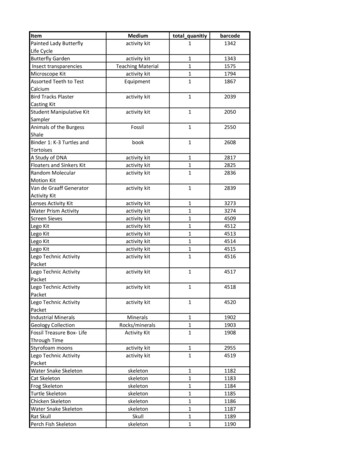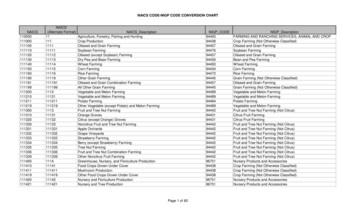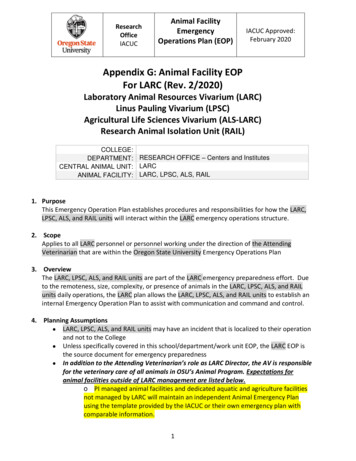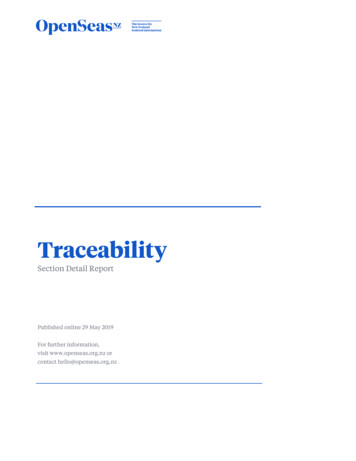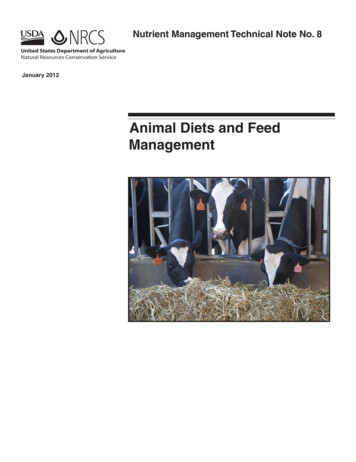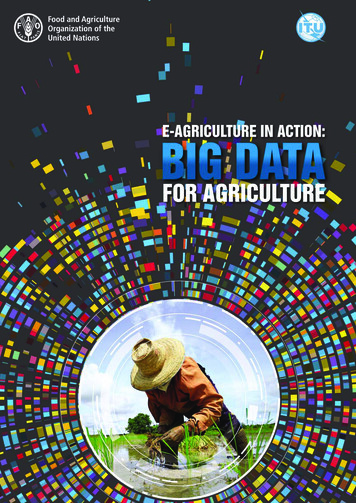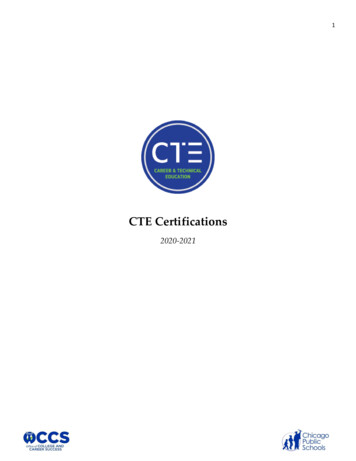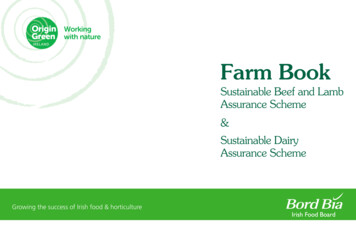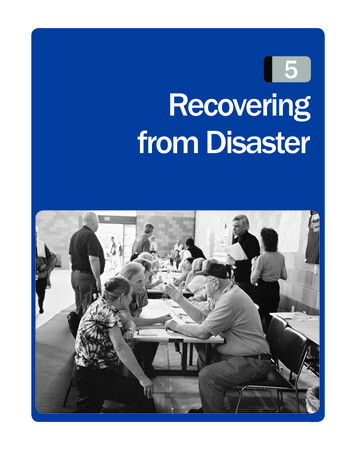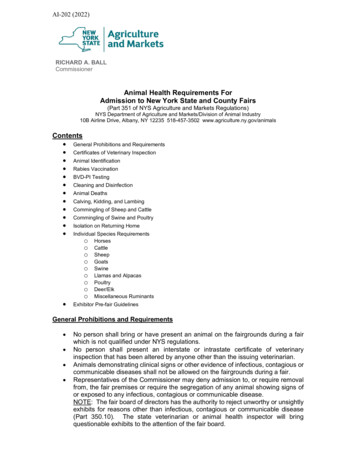
Transcription
AI-202 (2022)RICHARD A. BALLCommissionerAnimal Health Requirements ForAdmission to New York State and County Fairs(Part 351 of NYS Agriculture and Markets Regulations)NYS Department of Agriculture and Markets/Division of Animal Industry10B Airline Drive, Albany, NY 12235 518-457-3502 www.agriculture.ny.gov/animalsContents General Prohibitions and Requirements Certificates of Veterinary Inspection Animal Identification Rabies Vaccination BVD-PI Testing Cleaning and Disinfection Animal Deaths Calving, Kidding, and Lambing Commingling of Sheep and Cattle Commingling of Swine and Poultry Isolation on Returning Home Individual Species Requirementso Horseso Cattleo Sheepo Goatso Swineo Llamas and Alpacaso Poultryo Deer/Elko Miscellaneous Ruminants Exhibitor Pre-fair GuidelinesGeneral Prohibitions and Requirements No person shall bring or have present an animal on the fairgrounds during a fairwhich is not qualified under NYS regulations.No person shall present an interstate or intrastate certificate of veterinaryinspection that has been altered by anyone other than the issuing veterinarian.Animals demonstrating clinical signs or other evidence of infectious, contagious orcommunicable diseases shall not be allowed on the fairgrounds during a fair.Representatives of the Commissioner may deny admission to, or require removalfrom, the fair premises or require the segregation of any animal showing signs ofor exposed to any infectious, contagious or communicable disease.NOTE: The fair board of directors has the authority to reject unworthy or unsightlyexhibits for reasons other than infectious, contagious or communicable disease(Part 350.10). The state veterinarian or animal health inspector will bringquestionable exhibits to the attention of the fair board.
AI-202 (2022) All animals presented that originate from a location other than New York shall meetall New York State importation regulations appropriate to the species in addition tothe fair animal health requirements.Certificates of Veterinary Inspection (CVI) Cattle, sheep, goats, swine, llamas, alpacas, deer, and misc. ruminants require avalid CVI to enter the fairgrounds.The CVI must be issued by a Category 2 accredited veterinarian.All animals must be officially identified. ALL MANMADE ID MUST BERECORDED. Refer to Animal Identification section below for more information.Only one species is allowed per certificate.The type and duration of certificate required depends on the origin of the livestock.New York Origin Livestock: A valid intrastate CVI (AI-61) is required. Each animal must be individually identified on the CVI (see below). The CVI must be issued on or after May 1 of the current year.Out of State Origin Livestock: All animals entering New York State must satisfy import health and testrequirements for that species and be accompanied by a valid interstate CVI. The interstate CVI is valid for 30 days from the date of CVI inspection. During thefair season (July 1 through Labor Day) valid CVI’s can be used multiple times forentrance into fairs. The initial entrance into a NY fair must be within 30 days of thedate of CVI inspection. In order for the CVI to be used for a later fair, it must bedated and initialed by a NY state official noting the location of the initial fair. Achange in health status or eligibility of an animal necessitates the generation of anew CVI.Questions regarding import requirements should be directed to the Division of AnimalIndustry at 518-457-3971, or at the division’s import/export -import-export.Animal Identification ALL MANMADE ID MUST BE RECORDEDCattle must be identified by an official USDA approved ear tag. Radio frequencyidentification (RFID) ear tags, commonly referred to as “840 RFID tags,” arestrongly recommended.Sheep and goats must be identified by official scrapie identification (see sheep andgoat sections below).Swine must be identified by an official USDA approved ear tag. Radio frequencyidentification (RFID) ear tags, commonly referred to as “840 RFID tags,” arestrongly recommended. Nursing piglets do not have to be individually identified ifthe sow is correctly identified on the CVI and the number of piglets in the litter isnoted on the CVI.Llamas and alpacas must be identified by official ear tag or microchip.Misc. ruminants must be identified by unique ear tag or microchip.A complete written description is sufficient identification for horses entering NewYork accompanied by a CVI. The description must match the EIA test record.Horse sketches and descriptions should reference color pattern, hair whorls,chestnuts, scars, and other markings as necessary to uniquely identify the horse.Tattoos and microchips if any should be included. “Bay, no markings” is not anacceptable description for a CVI or EIA test record.
AI-202 (2022) NOTE: If you are exhibiting animals identified by microchip, a working reader mustbe supplied by the exhibitor.For questions on animal identification please contact your veterinarian or our officeat 518-457-3502.Rabies Vaccination Rabies vaccination is required for all species for which there is a USDA licensedvaccine available (cattle, horses, sheep, dog, cat, ferret) and that are 4 months ofage or older on the date of admission to the fair.o For most rabies vaccines, the earliest age allowable for primary vaccinationis 3 months. Animals that are vaccinated prior to 3 months of age will needto be re-vaccinated according to label before entering the fairgrounds. Vaccine must have been administered within the past 12 months. The exceptionis Imrab LA vaccine used in sheep which protects for 3 years after the secondannual vaccination (consult your veterinarian). The rabies vaccination requirement must be met on the day of admission even ifthe animal was previously admitted to a fair when too young to vaccinate. NOTE: Individual fairs can require animals for which there is no approved rabiesvaccine to be vaccinated for rabies. The requirements outlined above would apply.The fair is responsible for notifying exhibitors. The New York State Fair requiresrabies vaccination for all livestock species entering the grounds.Acceptable Proof of Rabies Vaccination Acceptable proof of rabies vaccination must include a signed written statementfrom the veterinarian administering the vaccine or a valid certificate of veterinaryinspection that has the vaccination listed and is signed by the Category 2accredited veterinarian. Acceptable proof of rabies vaccination must include the name of the product used,the date of administration, and the duration of immunity if longer than one year. If the statement of rabies vaccination is included on an EIA test record, it must besigned separately in addition to the required EIA test record signature. NOTE: Rabies titers are not acceptable proof of rabies protection and cannot beused to meet entry requirements. Acceptable proof of vaccination for dogs is a valid vaccination certificate or a copyof the dog license that contains the rabies vaccination information.BVD-PI Testing All cattle, llamas, and alpacas exhibited at NY county fairs or the State Fair mustbe negative to an approved test appropriate to detect Bovine Viral Diarrheapersistent infection (BVD-PI). The testing veterinarian is responsible to make surethe proper test is conducted. This is a once in a lifetime test that must be reportedon the required certificate of veterinary inspection. The issuing veterinarian isresponsible for verifying the validity of the test, the identification of the animal, andrecording the test date on the CVI. If a previous test is not verifiable the test mustbe repeated.Cleaning and Disinfection All buildings on the fairgrounds housing animals must be cleaned and disinfectedprior to the opening of the fair and between groups of animals when housing isrotated (Section 50.2 of Agriculture and Market regulations).Animal Deaths Occasionally animal deaths occur at a fair. If a death occurs it must be reportedto the state veterinarian in charge as soon as possible for review. The animal mustbe promptly removed from the public exhibit area to a secure location and held forthe veterinarian prior to disposal.
AI-202 (2022)Calving, Kidding, and Lambing Any cattle, goats, or sheep that calve, kid, or lamb while at a county fair or theState Fair will be ordered removed from the fairgrounds along with theiroffspring, unless the animals are part of a birthing demonstration.Commingling of Sheep and Cattle Due to the potential spread of malignant catarrhal fever from sheep to cattle, it isstrongly recommended that cattle be kept separate from sheep.Commingling of Swine and Poultry Due to the potential spread of influenza virus, it is recommended that swine andpoultry be housed in separate locations.Isolation on Returning Home The owner or custodian shall keep show animals biologically separate from theherd or flock for a period of at least two weeks after returning to the premises oforigin. If any illness is noted in the exhibition animals, the owner should contacttheir veterinarian immediately.Individual Species RequirementsHorses Certificate of Veterinary Inspection (CVI) is not required for New York originhorses. CVI is required for imported horses. Extended Equine CVIs (EECVIs) areacceptable. For more information on EECVIs, visit http://www.globalvetlink.com. Negative Equine Infectious Anemia (EIA) test is required for all horses 6 monthsof age or older. The horse must be accompanied by a valid negative EIA testrecord, signed by a Category 2 accredited veterinarian. The sample collection datefor the qualifying EIA test must have been on or after January 1, 2021 for NewYork origin horses. For imported horses, the EIA test must have been conductedwithin 12 months prior to entry. The EIA test certificate must include a completedescription of the horse. Rabies vaccination within 12 months is required for all horses 4 months of age orolder (see above).Cattle Certificate of Veterinary Inspection with animals properly identified. See AnimalIdentification section above. Rabies vaccination is required for all cattle 4 months of age or older (see above). All cattle must be negative to an approved test appropriate to detect Bovine ViralDiarrhea persistent infection (BVD-PI). The date and results of the testing mustbe noted on the certificate of veterinary inspection. All cattle must be vaccinated against bovine respiratory disease complex includingbovine respiratory syncytial virus, bovine virus diarrhea, infectious bovinerhinotracheitis and parainfluenza with a product administered in a manner and timeframe adequate to confer protective immunity for these diseases for the durationof the fair.Sheep Certificate of Veterinary Inspection with animals individually identified with USDAapproved scrapie identification. Identification must be one of the following: 1)USDA approved tags or 2) a legible USDA approved flock tattoo and individualanimal ID number or 3) electronic implant device (microchip) if the sheep is
AI-202 (2022) enrolled in the Scrapie Flock Certification Program. For information on scrapie ID,contact USDA at 1-866-USDA-TAG (1-866-873-2824).Rabies vaccination is required for all sheep 4 months of age or older (see above).The CVI must contain a written statement from the issuing Category 2 accreditedveterinarian that the flock of origin was inspected after May 1 of the current yearand no evidence of contagious, infectious or communicable diseases was found.If evidence of soremouth (contagious ecthyma) is found on any sheep, the entireexhibit including the affected animals shall immediately be removed from the fairpremises with the holding pens cleaned and disinfected immediately after removal.Goats Certificate of Veterinary Inspection with animals individually identified with USDAapproved scrapie identification. Identification must be one of the following: 1)USDA approved tags or 2) a legible registration tattoo or 3) a legible USDAapproved herd tattoo and individual animal ID number or 4) electronic implantdevice (microchip) if the goat is enrolled in the Scrapie Flock Certification Programand/or the electronic implant ID is recorded on the goat’s registration paper. Forinformation on scrapie ID, contact USDA at 1-866-USDA-TAG (1-866-873-2824). The CVI must contain a written statement from the issuing Category 2 accreditedveterinarian that the herd of origin was inspected after May 1 of the current yearand no evidence of contagious, infectious or communicable diseases was found. If evidence of soremouth (contagious ecthyma) is found on any goat, the entireexhibit including the affected animals shall immediately be removed from the fairpremises with the holding pens cleaned and disinfected immediately after removal.Swine Certificate of Veterinary Inspection with animals properly identified. See AnimalIdentification section above.Llamas and Alpacas Certificate of Veterinary Inspection with animals properly identified. See AnimalIdentification section above. All llamas and alpacas must be negative to an approved test appropriate to detectBovine Viral Diarrhea persistent infection (BVD-PI). The date and results of thetesting must be noted on the certificate of veterinary inspection.Poultry Poultry (with the exception of doves, pigeons and waterfowl) must be accompaniedby 1) results of a negative pullorum typhoid test conducted within 90 days prior toexhibition OR 2) proof that the birds originated directly from a US pullorum-typhoidclean flock or equivalent flock. Poultry qualified by 90-day test must be identified by official leg band. Proof of NPIP status must be in the form of an NPIP certificate or purchase receiptcontaining NPIP certification information. If utilizing a receipt, it must be datedwithin 1 year of the date of admission to the fair.Deer/Elk (Cervidae) Certificate of Veterinary Inspection with animals properly identified. See AnimalIdentification section above. Originate from a herd classified as accredited or qualified under USDA tuberculosisregulations. A movement permit obtained from the Division of Animal Industry is required forall deer movements. All CWD and TB program requirements must be met before
AI-202 (2022)a permit will be issued. Questions regarding movement permits should be directedto the Division of Animal Industry at 518-457-3502.Miscellaneous Ruminants Certificate of Veterinary Inspection with animals properly identified. See AnimalIdentification section above.Exhibitor Pre-fair GuidelinesCattle, Sheep, Goats, Swine, Llamas and Alpacas, Cervids, Misc. Ruminants Review the animal health requirements booklet including information foryour species before your veterinarian arrives to inspect your animals. Ifyou have any questions, ask. Your veterinarian is responsible for inspecting your animals andcompleting the certificate of veterinary inspection (CVI). Call early toavoid the last-minute rush when mistakes are made and there is no timeto correct. Make sure USDA approved official ear tags are present on cattle andswine and USDA approved scrapie ID is in place on sheep and goats. Llamas and alpacas require a microchip or ear tag. If a microchip isutilized make sure the veterinarian confirms the microchip ID or placesone. If your animal is identified by a microchip, make sure you bring aworking reader with you to the fair. ALL IDENTIFICATION MUST BE RECORDED. Make sure it is. Review the CVI carefully upon receipt to make sure all the information iscorrect including any required test or vaccination information. DO NOT stuff it in an envelope and assume all is well. The time to correctis before pulling them out at the fair. The CVI is your document and youshare responsibility if it is incorrect. If you are importing livestock from out of state, make sure the interstaterequirements are met and you have a valid interstate certificate ofveterinary inspection.Poultry Schedule pullorum flock inspection and testing well ahead of the fair ifyour flock is participating in the NPIP program. If you’re having your birds tested within 90 days of the fair you must go toa pullorum clinic. Available clinics are listed on the Dept. website. Noindividual testing is available if you miss a clinic. Birds qualified by 90-day test must be identified by official leg band. Bring documentation with you to the fair in the form of a 1) current NPIPcertificate, 2) 90-day test chart or 3) purchase receipt with NPIPcertification within 1 year of the date of admission to the fair.
AI-202 (2022)Horses NY origin horses must be accompanied by a negative EIA test report. Thedate of sample collection for the qualifying EIA test must have been on orafter January 1, 2020. Imported horses must be accompanied by an interstate certificate ofveterinary inspection with a negative EIA test within 12 months prior toentry. Rabies vaccination information can be incorporated into the CVI. Drawing or photograph must match the horse. Rabies vaccination must be within 1 year of arrival at the fair and bedocumented by a signed rabies certificate or a signed statement on theEIA test chart with the required information (see requirements).MOST IMPORTANTWhen you are loading your livestock for the trip to the fair, take the time toexamine them. Make sure they are the same animals that are on the paperworkand, if they are showing any signs of illness, LEAVE THEM HOME.
dated and initialed by a NY state official noting the location of the initial fair. A change in health status or eligibility of an animal necessitates the generation of a new CVI. Questions regarding import requirements should be directed to the Divisionof Animal Industry at 518-457-3971, or at the division's import/export homepage:
